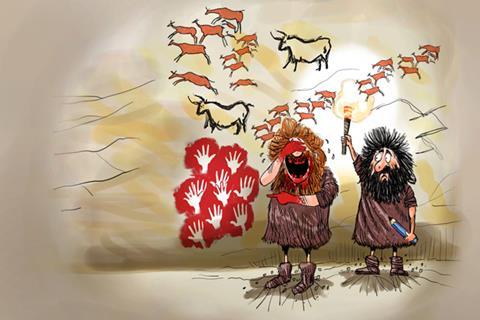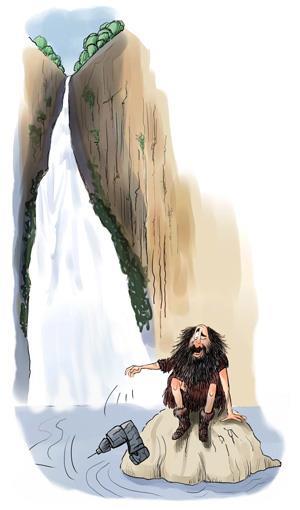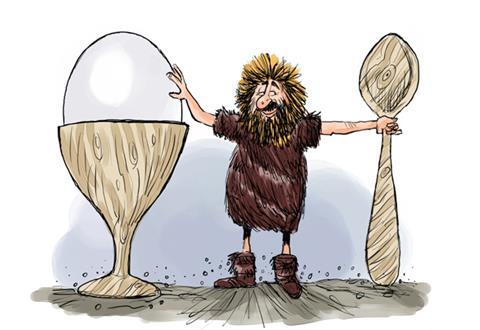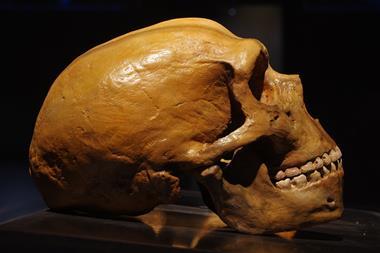Physical science is helping archaeologists close in on the real answers behind the mysteries of human evolution, finds Ida Emilie Steinmark

‘Dating is absolutely crucial, it underpins everything,’ says Michael Walker. Based at the University of Wales Trinity St David, he has devoted his career to studying the Quaternary period – the last 2.6 million years and the so-called ‘age of humans’. Though originally a field reserved for archaeologists, physical scientists like Walker are showing that they also have crucial contributions to make. With the help of new physical and chemical dating methods, scientists are finally beginning to discover how and when archaic species became… well, us.
‘The great breakthrough in Quaternary archaeology was radiocarbon dating,’ Walker says. Developed by Willard Libby in the 1940s – and winning him the Nobel prize in chemistry in 1960 – the basic principle of radiocarbon dating is simple: living things exchange carbon with their environment until they die. A portion of the carbon is the radioactive isotope carbon-14. At death, the exchange stops, and the carbon-14 then decays with a known half-life, which enables scientists to calculate the time of death.
However, it quickly became clear that something wasn’t quite right. ‘As is always the case, a new dating technique comes along and everyone latches onto it,’ explains Walker. ‘Then you start to find the problems with it.’ Atmospheric carbon variations, including variability in the all-important carbon-14, left the method unreliable. ‘It’s only in the last 20 years … that we could begin to correct for some of these variations in radiocarbon production,’ Walker says.
Although carbon dating is now more reliable, it has one major drawback: it only goes back 50,000 years, leaving most of human history outside its reach. So how do we investigate the development of human evolution if it’s outside the radiocarbon timescale? To get a clearer picture, scientists are exploiting diverse physical phenomena, from uranium’s radioactivity to life’s preference for l-amino acids.
Decoding cave art with uranium
A huge development in the story of humans is ‘modern’ behaviour, or acting like a human as opposed to acting like a two-legged ape – but it’s hard to date. For example, it’s difficult to say exactly when people started to think abstract thoughts or speak to communicate. Yet cave paintings are generally considered to be physical traces of early modern behaviour, because the creation of art requires abstract thought. And these can be dated – almost anyway. ‘The reason we started to look at dating cave art was because we had this slight conundrum,’ says Alistair Pike, an archaeologist at the University of Southampton in the UK. ‘When we look at genetics, they suggest that modern humans become anatomically modern between 150,000 and 200,000 years ago in Africa. But when you start looking at when humans behave like humans, it seems that this doesn’t match up with the date.’
Uranium dating will be enormously important in determining whether cave artists were Neanderthals or modern humans
Although the earliest cave art falls within the timescale of radiocarbon dating, it can’t be used for the paintings that Pike’s team were interested in. ‘Most archaeologists would turn to radiocarbon dating … [but] if you haven’t got organic pigment in there, you can’t use radiocarbon and you’d be destroying the art, which is very valuable. To take a normal radiocarbon sample would be unduly disruptive,’ he explains. Instead, Pike’s team turned to uranium-series dating, another radiometric method.
Uranium-238 decays through a series of isotopes to uranium-234, which then itself decays to thorium-230. It’s possible to measure the ratios of uranium-238/uranium-234 and thorium-230/uranium-238, the latter of which depends on the former. Since only uranium, and not thorium, is present at sample formation, comparing the two ratios can be used to calculate the time passed since the sample formed. For cave paintings, however, there’s a catch. Pike’s team are not actually dating the painting itself, but small calcite growths on top of it. ‘As it formed on top of the painting, it therefore gives you a minimum age of the painting,’ Pike says. This isn’t ideal, but it’s currently the best tool. ‘We’re kind of at the mercy of geochemistry.’
Pike’s team used this method to give a minimum date to red hand stencils found in a cave in northern Spain called El Castillo, which contains the oldest known cave art in the world. They found it was at least 37,290 years old. This is long after humans were supposed to become anatomically modern, adding to the evidence suggesting that early anatomically modern humans didn’t necessarily act modern. It also unleashed another mystery.
Anatomically modern humans arrived in northern Spain around 42,000 to 43,000 years ago, and Neanderthals died out between 39,000 and 41,000 years ago. But because the stencil date is a minimum age, there’s a chance the Neanderthals could have been the artists. ‘We’ve got dates that are tantalisingly close to the point at which modern humans arrived,’ explains Pike. ‘So we are continuing to focus on … hand stencils to see whether or not dates come out in the period where we know there were only Neanderthals in northern Spain.’
The issue of Neanderthal art regularly appears in the media, but is controversial in the academic world. For some, it fits in with emerging evidence that Neanderthals were an intelligent human species, but others remain unconvinced. Regardless, if there is evidence to find that Neanderthals were artists, dating will be the thing to expose it. According to Walker, the importance of this type of dating can’t be overestimated. ‘Uranium dating has been enormously important,’ he underlines.
Shining a light on technology
Like we recognise art as quintessentially human, we also consider tool use and technological progress to be defining for our species, and it was as important to ancient humans as it is to us. However, to discover how tool use relates to human evolution, scientists must be able to date it.

Kalambo Falls is an archaeological site on the border of Zambia and Tanzania with a magnificent tool record. The first excavations in the 1950s and 1960s revealed a hub of ancient human activity, spanning thousands of years’ worth of artefacts. Unfortunately much of it originates from outside radiocarbon dating’s timescale. ‘The chronology when we went to the site … was almost non-existent,’ says Geoff Duller, a geochronologist from the University of Aberystwyth in Wales. ‘Luminescence seemed a really good method to apply at this site because the artefacts were found in [river floodplain] deposits containing quartz grains.’
Quartz, and other minerals like feldspar, allow scientists like Duller to date objects using optically stimulated luminescence (OSL). In sediments there are radioactive isotopes that send out ionising radiation, which is absorbed by surrounding quartz, exciting some of its electrons. The excited electrons get trapped in the quartz’s crystal structure defects and are usually released by sunlight stimulation – but if the quartz is buried in the dark, they accumulate with continuous radiation. In the lab, a buried sample can then be optically stimulated to release the electrons and cause a luminescence signal with an intensity that depends on the absorbed radiation dose. It is therefore possible to calculate the burial time of the sample using the total radiation dose and rate.
According to Walker, OSL was a really exciting development when it was first discovered. ‘Previously you’d had to rely on those sediments containing organic material and date them with radiocarbon but now, hey presto, you could date by looking at the sediments themselves,’ he says. ‘And it’s been incredibly well refined within the last 10 years.’
However, traditional OSL also has a limiting timescale. ‘In the quartz, what we’re looking at is a defect in the crystal structure where we trap electrons,and the rate at which those fill, and when they become saturated is what produces the limit to our method,’ Duller explains. And this became a problem for some of the older sediments. ‘Once those defects are all occupied by electrons, our clock essentially can’t run anymore.’
Traditional OSL only goes back around 100,000 years. Duller and his team therefore had to come up with a way to extend its application to get a full chronology. ‘We were trying to find different defect centres that we could look at,’ says Duller, ‘One method in particular is known as thermally transferred OSL dating.’ By using different defect centres, TT-OSL has a much higher saturation dose than normal OSL and therefore can analyse over a much longer timescale. ‘This method we used on the older sediments, getting dates back to 300,000–500,000 years ago,’ he says.
It’s still unclear how far back this new method can stretch, but Duller thinks they are probably nearing the limit at half a million years. For Kalambo Falls, however, this was enough – the site now has a chronology of its artefacts that, despite large error bars, has given it the scientific authority it deserved in the discussion of human technological progress.
Dating in an eggshell
Rigorous refinement of dating methods, like the development of TT-OSL, has been necessary to tackle the new problems that constantly arise. This also holds true for amino acid racemisation dating (AAR). ‘Amino acid dating came on the scene in the 1970s with a bang,’ Walker says. ‘All sorts of exciting possibilities looked like they were emerging, but then it hit a very rough patch.’ Theoretically, the principle is elegant: all living things keep their amino acids in the l configuration, but when they die, their amino acids will start to racemise. Because they make their way towards equilibrium at a known rate, the ratio between d and l configurations can be used to determine when the organism died. So what was the problem?

Racemisation is influenced by parameters such as pH, temperature and humidity, meaning that unless a sample’s exact historical environment is known, the elegant base principle becomes muddy and messy. So Kirsty Penkman, an analytical chemist at the University of York in the UK, knew she had her work cut out for her: ‘We were trying to re-look at amino acid dating and work out from a chemical perspective why there had been issues with some of the amino acid dates at a small number of sites.’
Her approach has been to change target. Instead of normal protein, she uses ‘intra-crystalline’ protein fragments to battle the biggest problem: contamination. ‘We wanted to isolate what effectively operates as a closed system within the fossil biominerals,’ Penkman explains. ‘It had been postulated … that there might be some proteins that were physically entrapped within the crystal, as opposed to between the crystals, of calcium carbonate minerals. With this work, we’re picking this up.’
The intra-crystalline fractions are obtained by crushing samples and exposing them to prolonged wet chemical oxidation. This destroys contamination and any unprotected proteins, effectively leaving a closed system. The amino acids within the remaining fraction can then be analysed for racemisation, enabling the intra-crystalline decomposition to be determined. ‘The advantage of dating something like this is that you don’t have to worry about all the environmental factors that can affect the protein, such as pH and catalysts in the soil,’ Penkman says.
We’ve got some beautiful dating results from eggshells
However, the effect of temperature currently can’t be eliminated and therefore the method remains a ‘relative’ dating method – it can rank fossils but not provide an age in calendar years. Theoretically, with a known temperature record, it might be possible to disentangle the effect of temperature and time, but gaining temperature records over those timescales is incredibly difficult.
Instead Penkman uses the ranking obtained through AAR and calibrates it against other independent dating measures. The new intra-crystalline AAR dating has the potential to seriously improve dating on a range of biominerals. ‘We … turned our attention to ostrich eggshell because there had been some work done in the 90s that showed that ostrich eggshell also potentially contained closed system protein,’ she explains. It’s a biomineral that is often found at archaeological sites and therefore could help to elucidate human evolution.
Through history, humans have eaten eggs both from giant extinct birds and more regular-sized fowl, and their presence can be used for indirect dating. The only major thing that must be considered is if the eggs have been treated with fire, as this radically throws off their racemisation. However, through careful calibration, Penkman’s team has successfully been able to find and exclude unusable shell. ‘It’s gone really well – we’ve got some beautiful dating results from the eggshells,’ Penkman says.
Walker, too, is impressed with the results. ‘Amino acid dating is something which has started to move forward again, Kirsty Penkman has really turned [it] around,’ he says. ‘The work she’s been doing has been enormously important.’ What secrets intra-crystalline AAR dating will be able to uncover remains to be seen, but its success sure seems to be gathering pace.
And the overwhelming feeling, having peeked into the diverse landscape of modern dating, is undeniably one of progress. Radiocarbon might have climbed over its initial hurdles and may still be the dating of choice for most archaeologists, but the whole field has moved forward, filling the holes and overcoming the limitations set by traditional techniques. Our perspectives on questions about modern human behaviour and the development of new tools are changing, achieving a new level of certainty and accuracy. Who knows – maybe one day the ins and outs of the human past will have been entirely revealed, date by date by date.
Ida Emilie Steinmark is a science writer in Glasgow, UK












No comments yet